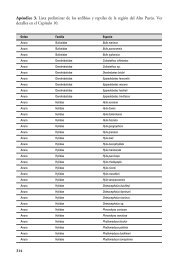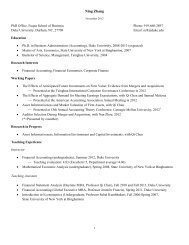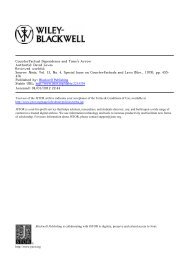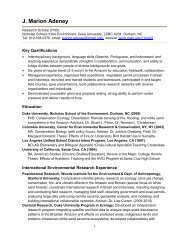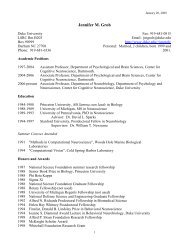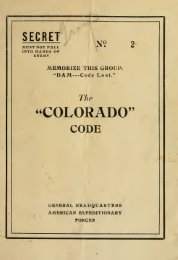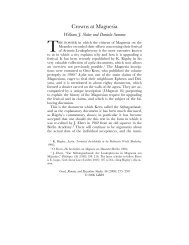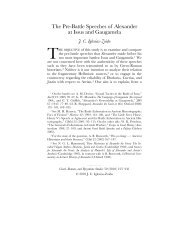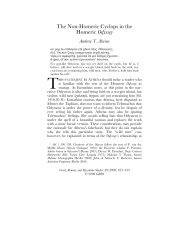Johann Wolfgang von Goethe (1749-1832) - Duke University
Johann Wolfgang von Goethe (1749-1832) - Duke University
Johann Wolfgang von Goethe (1749-1832) - Duke University
Create successful ePaper yourself
Turn your PDF publications into a flip-book with our unique Google optimized e-Paper software.
J. W. v. <strong>Goethe</strong> Page 8 4/4/2008<br />
rather distant basis. Christiane bore <strong>Goethe</strong> several<br />
children, only one of whom--Julius August<br />
Walther, born in 1789--survived, and remained his<br />
companion until her death. Their marriage in 1806<br />
did little to moderate the Weimar court's<br />
disapproval of <strong>Goethe</strong>'s scandalous liaison with his<br />
uneducated "dicke Hälfte" (fatter half), as she was<br />
cruelly called, but their persistence in this situation<br />
is a measure both of their devotion to one another<br />
and of <strong>Goethe</strong>'s distance from his immediate circle.<br />
Indeed, he lived thereafter in a world of ideas and<br />
intellectual activities rather than in a world of<br />
events. Even the Italian journey, which he treasured<br />
for the rest of his life, was important to him as a<br />
remembered experience: he was not at all pleased<br />
when the duke dispatched him to Venice in 1790,<br />
though he used the time to learn more about<br />
Venetian painting. In Weimar he devoted his<br />
energy to studies of all sorts. In addition to his<br />
earlier interests in geology, botany, and<br />
comparative anatomy he became passionately<br />
interested in optics, and in 1790 he began<br />
publishing increasingly anti-Newtonian essays<br />
about the theory of color and scientific method in<br />
general. Much of his time was devoted to studying<br />
Kant, Plato, and Homer. His other major area of<br />
interest was art. This more academic development<br />
of his interests was reflected in his new friendships<br />
with the educator and statesman Wilhelm <strong>von</strong><br />
Humboldt and the art historian Hans Meyer; the<br />
latter, whom he had met in Italy, lived in his house<br />
from 1791 until 1802. The French Revolution was<br />
the one political event that necessarily impinged on<br />
<strong>Goethe</strong>'s life, not only because it was a topic of<br />
constant interest in all circles but also because the<br />
duke, who had entered the Prussian army, insisted<br />
that <strong>Goethe</strong> accompany him on campaigns to<br />
France in 1792 and to the Rhine in 1793. <strong>Goethe</strong><br />
reported on these events in "Campagne in<br />
Frankreich 1792" (translated as The Campaign in<br />
France in the Year 1792, 1849) and "Belagerung <strong>von</strong><br />
Mainz" (Siege of Mainz), published together in<br />
1822. He continued his optical and artistic studies<br />
while trudging around after the army; his refusal to<br />
be submerged in military activity enabled him to<br />
present a clear picture of the daily reality of the<br />
campaigns.<br />
<strong>Goethe</strong>'s literary output in the early 1790s was<br />
relatively sparse. Two short plays, Der Groß-<br />
Cophta: Ein Lustspiel in fünf Aufzügen (The Great<br />
Cophta, 1792) and Der Bürgergeneral: Ein<br />
Lustspiel in einem Aufzuge. Zweyte Fortsetzung der<br />
beyden Billets (The Citizen General, 1793), and a<br />
dramatic fragment, Die Aufgeregten (The Excited<br />
Ones, published in 1817), deal with the French<br />
Revolution in poetic terms. The verse epic<br />
Reineke Fuchs (1794; translated as Reynard the<br />
Fox, 1855), does so more effectively. This<br />
translation and adaptation into hexameter of a<br />
Low German version of the old story of the fox<br />
at the court of the lion is the first result of<br />
<strong>Goethe</strong>'s study of Homer. But the most<br />
important poetry of these years is the cycle of<br />
love poems "Römische Elegien" (1795; translated<br />
as Roman Elegies Translated in the Original Metres<br />
, 1876), written in the first year of his<br />
relationship with Christiane. The poems<br />
describe the gradual acceptance of a German<br />
visitor into the Roman world of history, love,<br />
art, and poetry. As the poet takes possession of<br />
his Roman beloved, so too does he enter into the<br />
cultural heritage represented by Rome to the<br />
eighteenth century and everything represented<br />
by the south to the Gothic north. Written in the<br />
elegiac couplets of Propertius, Catullus, and<br />
Ovid, and in their frank manner, the poems<br />
transmute their Roman predecessors with the<br />
same facility and success as <strong>Goethe</strong>'s classical<br />
plays appropriate their predecessors. They<br />
created something of a scandal when they were<br />
published but are now recognized as the<br />
greatest love poems of the generation.<br />
The year 1794 marks the beginning of <strong>Goethe</strong>'s<br />
friendship with Schiller. Schiller had come to<br />
Jena in 1789 as professor of history on an<br />
appointment arranged by <strong>Goethe</strong>, but the older<br />
poet had had two reasons for keeping his<br />
distance from the newcomer: not only had<br />
Schiller made his reputation as a powerful<br />
Sturm und Drang poet a decade after <strong>Goethe</strong>



